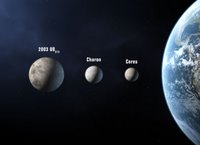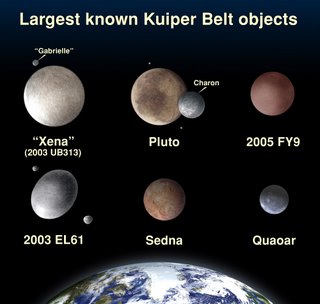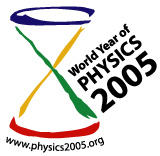India's technological leap in space technology.
Madhavan speaks about Chandrayan mission to moon
NASA Moon landing conspiracy - MSNBC 2002
Friday, November 14, 2008
Wednesday, September 10, 2008
Behind the Scenes of LHC
Geneva, 10 September 2008. The first beam in the Large Hadron Collider at CERN was successfully steered around 27 kilometers of the world’s most powerful particle accelerator at 10h28 this morning. This historic event marks a pivotal moment in the transition from over two decades of preparation to a new era of scientific discovery. Read more....
Geneva, 5 September 2008. A report published today in the peer-reviewed journal Journal of Physics G: Nuclear and Particle Physics provides comprehensive evidence that safety fears about the Large Hadron Collider (LHC) are unfounded. The LHC is CERN’s new flagship research facility. As the world’s highest energy particle accelerator, it is poised to provide new insights into the mysteries of our universe.
Read more about the following.
- Cosmic Rays
- Microscopic Black holes
- Strangelets
- Vacuum Bubbles
- Magnetic Monopoles
Safety of LHC: http://public.web.cern.ch/public/en/LHC/Safety-en.html
Behind the scenes
Labels:
CERN,
Higgs Bosons,
Standard Model,
String theory
Sunday, August 24, 2008
How does the universe work? Get ready for the answer on Sep 10, 2008
Geneva, August 11th 2008. The synchronization of the LHC's clockwise beam transfer system and the rest of CERN's accelerator chain was successfully achieved last weekend. read more ..
Countdown to LHC First Beam 16 days more ... September 10th, 2008
After a quarter of a century of dreaming and planning, designing and building, at last we are about to see the LHC completed.
Frank Close, Rudolf Peierls Centre for Theoretical Physics, Oxford University, is a former head of CERN's Communication Group. He recently visted CERN to give lectures to the summer students.
Already the excitement is gathering at the prospect of what will be discovered: possibly the Higgs Boson, or supersymmetry, or even things that no one has thought of. The world's media are already abuzz with anticipation. But we are getting ahead of ourselves. The visions of the new world will hopefully be tomorrow's stories; today, let's reflect on what has been achieved at even getting to this point and recall what it was like long ago when the dream began: in those bygone days, were you sure that the LHC would ever be?
Hadron headbanger machine chilled to ramming speed By Lewis Page
Scientists operating from a hollowed-out lair deep beneath the Franco-Swiss border have announced that their enormous, unprecedentedly powerful 27-kilometre proton cannon will shortly be ready to open fire. To be precise, "first beam" is scheduled for September 10th.
Uncharacteristically, perhaps, the boffins made their announcement via a normal press release rather than by seizing command of TV broadcasts. The traditional demand for a colossal sum of money to be paid by the world's governments on pain of cities erased hourly was also omitted - perhaps because these boffins have already received such funds in order to build their immense machine. read more...
Labels:
CERN,
Higgs Bosons,
LHC,
Particle Accelerators
Friday, August 22, 2008
The ultimate expirement
BBC Horizon - Six Billion dollar experiment
LHC - The ultimate experiment
LHC - The ultimate experiment
Labels:
Big Bang,
Bosons,
LHC,
Mass,
Quantum Physics,
Quarks,
Standard Model
Friday, August 15, 2008
Gravity and other Forces - Elegant Universe
Elegant Universe - Einstein's Relativity
String theory
String theory
Labels:
Albert Einstein,
Garvity,
Newton,
Relativity,
Speed of Light
Saturday, July 26, 2008
Wednesday, January 23, 2008
Life on Mars
| Is there life on Mars? |
A magnified version of the picture, posted on the internet, appears to some to show what resembles a human form among a crop of rocks.
While some bloggers have dismissed the image as a trick of light, others say it is evidence of an alien presence.
The image is a recent Nasa posting of the Spirit's landing in 2004.Read more in ... BBC http://news.bbc.co.uk/2/hi/science/nature/7205004.stm
Thursday, August 24, 2006
Pluto loses status as a planet
Astronomers meeting in the Czech capital have voted to strip Pluto of its status as a planet. About 2,500 experts were in Prague for the International Astronomical Union's (IAU) general assembly.
The scientists rejected a proposal that would have retained Pluto as a planet and brought three other objects into the cosmic club. Pluto has been considered a planet since its discovery in 1930 by the American Clyde Tombaugh.
The scientists rejected a proposal that would have retained Pluto as a planet and brought three other objects into the cosmic club. Pluto has been considered a planet since its discovery in 1930 by the American Clyde Tombaugh.
The ninth planet will now effectively be airbrushed out of school and university textbooks.
Wednesday, August 23, 2006
Astronomers lean towards eight planets
Finally, astronomers could be homing in on a definition of the word planet. After a day of public bickering in Prague, followed by negotiations behind closed doors, the latest draft resolution was greeted with a broadly friendly reception.
If accepted on Thursday, it would be bad news for Pluto, which would no longer be a full-fledged planet.
read more in New Scientist
Tuesday, August 22, 2006
Found Dark Matter
 Dark Matter which makes up 25% of the Universe finally detected. Dark matter eluded scientists for years as it doesn’t emit or reflect light. Scientists found proof of dark matter in the galaxy cluster 1E0657-556. The evidence provided by a cosmic collision between two huge clusters of galaxies. As per Maxim Markevitch of the Harvard Smithsonian Center in Cambridge, Massachusetts, it is the “most energetic cosmic show, besides the Big Bang” that we are aware of.
Dark Matter which makes up 25% of the Universe finally detected. Dark matter eluded scientists for years as it doesn’t emit or reflect light. Scientists found proof of dark matter in the galaxy cluster 1E0657-556. The evidence provided by a cosmic collision between two huge clusters of galaxies. As per Maxim Markevitch of the Harvard Smithsonian Center in Cambridge, Massachusetts, it is the “most energetic cosmic show, besides the Big Bang” that we are aware of.Image to right: A purple haze shows dark matter flanking the "Bullet Cluster." Image Credit: X-ray: NASA/CXC/M.Markevitch et al. Optical: NASA/STScI; Magellan/U.Arizona/D.Clowe et al. Lensing Map: NASA/STScI; ESO WFI; Magellan/U.Arizona/D.Clowe et al.
 The known universe (to us) is composed of 5% of matter (which includes, Free Hydrogen & Helium, Stars, Heavy elements (Earth), Ghostly neutrinos, air, life etc) while the rest 95% is made up of Dark Matter and Dark Energy. The matter in the known universe is made up of Quarks (Up and Down) and Electrons. Proton consists of 2 Up Quarks and 1 Down Quark while Neutron consists of 2 Down Quark and 1 Up Quark. This is the first family of fermions in the standard model.
The known universe (to us) is composed of 5% of matter (which includes, Free Hydrogen & Helium, Stars, Heavy elements (Earth), Ghostly neutrinos, air, life etc) while the rest 95% is made up of Dark Matter and Dark Energy. The matter in the known universe is made up of Quarks (Up and Down) and Electrons. Proton consists of 2 Up Quarks and 1 Down Quark while Neutron consists of 2 Down Quark and 1 Up Quark. This is the first family of fermions in the standard model.The scientists discovered the gravitational signature of the dark matter. This signature is the by product of an immense collision of two huge galaxies (happened 100 million years ago) tearing apart the normal matter and the dark matter. The kinetic energy of this collision is good enough destroy planet Earth ten trillion trillion times. The dark matter is not seen, however, its gravity has a predictable effect on the observations. The blue color in the image shows gravity fields observed by how light from each background galaxy is distorted.
As per Robert Roy Britt of Space.Com here’s what the image reveals:
“The hot gas – normal matter – was slowed by a drag force described as the cosmic equivalent of air resistance. But the dark matter was not slowed by this effect, presumably because it does not interact with normal matter, as theory had predicted. So the normal matter and dark matter became separated.”
References
1. AstroPhysics - A direct empirical proof of the existence of Dark Matter
2. BBC – Team finds ‘proof’ of dark matter
3. CNN – Scientists: Dark Matter exists!
4. Space.Com – Colossal cosmic collision reveals dark matter
5. NASA – A Matter of fact
6. BBC – Dark Matter comes out of cold
7. Wikipedia.org – Dark Matter
8. Wikipedia.org – Dark Energy
9. Scientific American - Colliding Clusters shed light on Dark Matter
10. Scientific American - Supernovae Back Einstein's Blunder
Labels:
Big Bang,
Dark Matter,
Galaxies,
Standard Model
Saturday, August 19, 2006
Astronomers sharply divided on new planet definition
By Robert Roy Britt, SPACE.com
A 12-person committee representing the world's largest group of planetary scientists on Thursday threw its support behind a new planet-defintion proposal that would increase the tally of planets in our solar system to 12. More dissent emerged, too, from several prominent planet experts.
The definition, proposed yesterday at a meeting of the International Astronomical Union (IAU) in Prague, preserves Pluto's planet status and essentially classifies as planets all round objects that orbit the Sun and do not orbit another planet. The tally of planets is expected to eventually soar into the hundreds if the resolution is passed by a vote next week.
The Division for Planetary Sciences (DPS), a group within the American Astronomical Society, has the opposite view. The 12-member DPS Committee, elected by the membership, "strongly supports the IAU resolution," according to a statement released Thursday.
read more .... usatoday.com
Earth's moon could become a planet
By Robert Roy Britt SPACE.com
Friday, August 18, 2006; Posted: 12:11 p.m. EDT (16:11 GMT)
(SPACE.com) -- If astronomers approve a newly proposed planet definition next week, things could get really strange. Sure, asteroid Ceres will become a planet. Pluto's moon Charon will become a planet. But we're talking really strange.
Eventually, if Earth and its moon survive long enough, the moon will have to be reclassified as a planet, said Gregory Laughlin, an extrasolar planet researcher at the University of California, Santa Cruz.
The new definition, proposed this week by the International Astronomical Union (IAU), basically says every round object orbiting the sun is a planet, unless it orbits another planet. But there is a big caveat: If the center of gravity, called the barycenter, is outside the larger object, then the smaller object is a planet. That wording elevates Pluto's moon Charon to planethood, an idea some astronomers have criticized
read more in .... cnn.com
Pluto may yet lose planet status
Stephen Battersby - 20:24 18 August 2006 - NewScientist.com news service
We were about to gain a horde of new planets; now we might lose one instead.
In Prague, astronomers are trying to define what it means to be a planet. A draft definition released on Wednesday would have extended the the club from the conventional nine to twelve, and soon to many more (see Three new planets may join solar system).
read more in ..... New Scientist
Wednesday, August 16, 2006
Solar System with 12 Planets
 IAU’s executive committee submitted (which only submits recommendations likely to get two thirds approval from the group of 2500 astronomers from 75 nations meeting in Prague to decide a universal definition of a planet) a draft proposal to expand the Solar System to 12 planets. They will have two brain storming sessions before they vote on the resolution next week (August 21-25, 2006).
IAU’s executive committee submitted (which only submits recommendations likely to get two thirds approval from the group of 2500 astronomers from 75 nations meeting in Prague to decide a universal definition of a planet) a draft proposal to expand the Solar System to 12 planets. They will have two brain storming sessions before they vote on the resolution next week (August 21-25, 2006).The change will force the schools across the world to change their text books and the elementary school solar system models. More interestingly astrologers need to tweak their formulas to make predictions as their model of classic nine planets is not valid anymore! :-)
The proposed new definition of a planet is as follows

- Any round object larger than 500 miles (800 Km) in diameter
- It must orbit the sun
- A mass roughly one-12,000th that of Earth.
Pluto and its moon Charon will be first double planet while Ceres is only 592 miles (952 Km) in diameter compared to 2003 UB313 which is 1490 miles (2400 km) in diameter.
Following will be the 12 planets if the resolution is approved (diameter in brackets)

1. Mercury (3031 miles)
2. Venus (7520 m)
3. Earth (7926 m)
4. Mars (4194 m)
5. Ceres (592 m)
6. Jupiter (88,736 m)
7. Saturn (74,978 m)
8. Uranus (32,193 m)
9. Neptune (30,775 m)
10. Pluto (1430 m)
11. Charon (750 m)
12. 2003 UB313 or Xena (1490 m)
Images
In this artist's impression the planets are drawn to scale, but without correct relative distances.
Credit: The International Astronomical Union/Martin Kornmesser
Resources
1. IAU.org – Draft Definition of planet and plutons
2. BBC – Planets plan boosts tally to 12
3. BBC – Proposed new planets (video)
4. New York Times – For now, Pluto holds its place in our Solar System
4. CNN – Proposal would increase planets from 9 to 12
5. Scientific American – New Planet Definitions Enlarges Solar System
6. Telegraph UK - Never mind the dwarfs, just be happy for pluto
Wednesday, October 12, 2005
10th Planet - 2003 UB313
 Astronomers discovered the 10th Planet of our Solar System. Neptune was discovered in 1846 and Pluto in 1930. Astronomers named this object as UB313 (granted automatically according to the IAU – International Astronomical Union’s naming protocols for minor planets), which is larger than Pluto and has a moon. UB313 takes close to 557 years to orbit the sun and it currently lies almost its maximum distance from the Sun (97 Astronomical Units). Astronomers calculated the diameter of UB313 around 1490 miles (2400 km - using images from the Hubble Space Telescope) and Pluto is around 1433 miles. Observations taken on September 10, 2005 revealed a moon in orbit around UB313. The moon was nicknamed Gabrielle by its discoverers. The unofficial name for UB313 is Xena (Xena – The warrior Princess).
Astronomers discovered the 10th Planet of our Solar System. Neptune was discovered in 1846 and Pluto in 1930. Astronomers named this object as UB313 (granted automatically according to the IAU – International Astronomical Union’s naming protocols for minor planets), which is larger than Pluto and has a moon. UB313 takes close to 557 years to orbit the sun and it currently lies almost its maximum distance from the Sun (97 Astronomical Units). Astronomers calculated the diameter of UB313 around 1490 miles (2400 km - using images from the Hubble Space Telescope) and Pluto is around 1433 miles. Observations taken on September 10, 2005 revealed a moon in orbit around UB313. The moon was nicknamed Gabrielle by its discoverers. The unofficial name for UB313 is Xena (Xena – The warrior Princess).Links

1. space.com - Objects bigger than Pluto Discovered
2. Wikipedia.org – UB313
3. bbc.co.uk – Astronomers detect 10th Planet
4. Caltech.edu – Discover of 2003 UB313
5. Astronomy.com – Move over, Pluto. There is even a larger ice world out there.
6. ub313.com – New Planet
7. nasa.gov – UB313
8. iau.org – International Astronomical Union
9. iau.org – Trans Neptune Object 2003 UB313
* Image Courtesey - Wikipedia.org
Friday, September 30, 2005
Physics 2005 - Celebrating 100 years
 Year 2005, celebrating the 100 years of Einstein’s miraculous year 1905. 100 years ago in the month of September 1905 Einstein gave the final equation to the world – The most famous equation E = mc².
Year 2005, celebrating the 100 years of Einstein’s miraculous year 1905. 100 years ago in the month of September 1905 Einstein gave the final equation to the world – The most famous equation E = mc². Here are the two complimentary lectures by Prof Richard Wolfson Ph.D, Middlebury College on Albert Einstein's miraculous year 1905 (presented by the Teaching Company).
- Lecture 1 (32 minutes) – Real Audio
- Lecture 2 (32 minutes) – Real Audio
- The Teaching Company - Einstein’s Relativity and the Quantum Revolution: Modern Physics for Non-Scientists, 2nd Edition (24 lectures, 30 minutes/lecture) By Prof Richard Wolfson.
Further Reading
Internet
Internet
- New York Times – Brian Green – The Famous Equation and You (June 30, 2005)
- PBS – E = mc² explained
- PBS – Relativity and Cosmos
- Physics 2005 – Celebrating 100 years
Albert Einstein – Image and Impact
Labels:
Albert Einstein,
Quantum Revolution,
Relativity,
Year 1905
Saturday, February 05, 2005
Getting closer to God Particle
Peter Higgs a British physicist predicted the existence of Higgs particle in sixties to explain how matter has mass. His theory suggested that Higgs gives rise to a field through which all other sub atomic particles (fermions) such as quarks, electrons and force carrier particles (bosons) such as photons, gluons, W & Z bosons must pass. When they (particles) interact with the field, the particles experience a drag, the more the drag, the more massive the particle.
The basic idea of all pervading Higgs field (which is carried by Higgs bosons) is an important part of the Standard Model of particles and forces, for it explains the masses of the carriers of the weak force, responsible for beta-decay1 and for nuclear reactions that fuel the Sun.
Most of the matter (known) in the universe is composed of up quark, down quark and electron (up quark has 2/3 charge while down quark has -1/3 charge). Proton consists of 2 up quarks and 1 down quark while Neutron consists of 2 down quarks and 1 up quark. This is the 1st family of the fermions in the standard model.
% | Composition of Universe |
00.03 | Heavy Elements (Earth) |
00.30 | Ghostly Neutrinos |
00.50 | Stars |
04.00 | Free Hydrogen and Helium |
25.00 | Dark Matter |
70.00 | Dark Energy |
The unsolved mysteries - Beyond the standard model?
We know the ingredients for the known (5%) part of the universe (refer the table above). So, what about unknown universe, which comprises of dark matter and dark energy?
Are quarks and leptons the fundamental particles?
Why there are exactly three generations (fermions) of quarks and leptons?
What is the role of second and third generation of fermions when most of the known (5%) universe is composed of 1st generation of fermions?
If there is symmetry between matter and anti-matter in the universe, why do we observe matter and virtually no anti-matter?
How does gravity fit into all these quantum stuff?
Let us hope to find these answers in this decade. Here is an interesting article by John Womersley of Fermi Lab about Standard Model infact going beyond the standard model.
Beyond the Standard Model
by John Womersley, Fermilab February 05, 2005
by John Womersley, Fermilab February 05, 2005
At almost any particle physics conference, meeting, or lunch table, the phrase “physics beyond the Standard Model” is heard over and over again. What’s wrong with the Standard Model, anyway? Why are physicists so sure that there is something beyond it? And why do they think they can find it anytime soon? .. continue ..
Beta decay is one process that unstable atoms can use to become more stable. There are two types of beta decay, beta-minus and beta-plus. In Beta-minus a neutron will become a proton (and an electron and an antineutrino will fly away from the nucleus) and in Beta-plus a proton will become a neutron (and a positron and a neutrino will fly away from the nucleus).
Labels:
Bosons,
God Particle,
Quantum Physics,
Quarks
Subscribe to:
Comments (Atom)








